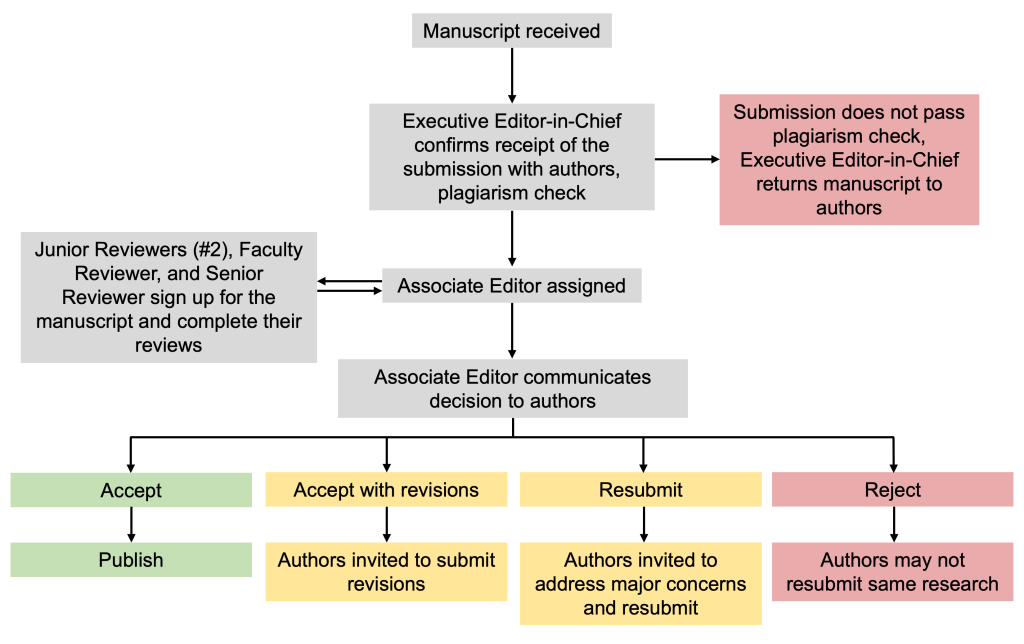
- Some initial rejections may be allowed to be resubmitted if initial quality of the manuscript is not suitable for review, but the topic still fits within the scope of MSRJ.
- Each manuscript is reviewed by two Junior Reviewers and a Faculty Reviewer. A Senior Reviewer then synthesizes all three reviews and makes a final recommendation to the Associate Editor.
- After a final check with the Executive Editor-in-Chief, the Associate Editor communicates the publication decision to the authors. The types of reviewer decisions are described here.
- If necessary, the authors will then be expected to make necessary changes and submit the new document with a formatted response.
- The Associate Editor will be in contact with the authors until the changes are deemed acceptable.
- When all needed changes have been made, the submission will be sent to the copy editor.
- The copy-edited and formatted manuscript will be reviewed by the authors, Senior Reviewer, Associate Editor, and Executive Editor-in-Chief to ensure that the manuscript is finalized before publishing.
- Finally, the manuscript will be published online and included in the subsequent issue of MSRJ.
Timeline from submission to publication
This page elaborates on the timeline of the submission process. The review process should be read first.
- A submission is received, and queued for review by Executive Editor-in-Chief.
- The Executive Editor-in-Chief takes 3-5 days to decide if the manuscript is appropriate for the journal.
- Once the Student, Faculty, and Senior Reviewers are assigned, it will take approximately 4-6 weeks to complete their reviews.
- Shortly after all reviews are completed, the compilation of reviewer comments by the Senior Reviewer with a decision will be sent to the author by the Associate Editor.
- Depending on the decision, the author will have a set amount of time to return the manuscript with any requested changes. This process is variable because multiple rounds of editing may need to take place.
- Once accepted for publication, copy editing takes 2-3 weeks.
- After final review by the authors, Senior Reviewer, Associate Editor, and Executive Editor-in-Chief, the article will be published online immediately, then included in the subsequent issue of MSRJ (time to publication in the next issue of MSRJ depends on when the article is published).
Please note these timeframes are approximate and dependent upon reviewer engagement. The review process may be delayed as we work to find a full reviewer team for your submission.
Potential Outcomes of the Review Process
Once the reviewers have completed the reviewing process regarding the submitted manuscript, there are 4 possible outcomes described below:
1. Accept without Revisions: The manuscript is ready for publication in its original form and no revisions are required. Only superficial changes such as grammar, spelling, and formatting will be made.
2. Accept with Revisions: This is a fine manuscript that is nearly publishable, but some minor or major flaws require attention; the manuscript is provisionally accepted and will be published provided the authors make the revisions suggested by the reviewers. Authors are asked to explain if comments are not able to be met, or if the manuscript cannot be modified as suggested. Responses must be formatted according to our author response guide. To enable timely publication, the authors are generally given 2 weeks to complete the revisions.
3. Resubmit: This decision is neither an acceptance nor a decline. In order for your manuscript to be reconsidered in another round of review, the manuscript must be edited according to the suggestions made by the reviewers and faculty adviser. Three new reviewers will evaluate whether or not the resubmission is adequate. Authors are asked to explain if comments are not able to be met, or the manuscript cannot be modified as suggested. We ask that the revised manuscript be sent back with the changes, and a copy of author responses to each reviewer’s comments be submitted as well, according to our author response guide. To enable timely publication, the authors are generally asked to complete the revisions in 3-4 weeks.
4. Reject: A decline status indicates the manuscript is not appropriate for the journal or does not meet the quality of MSRJ for publishing. No further revisions will be considered. Authors will still receive reviewer comments and suggestions for improving the manuscript for submission to a different journal.
